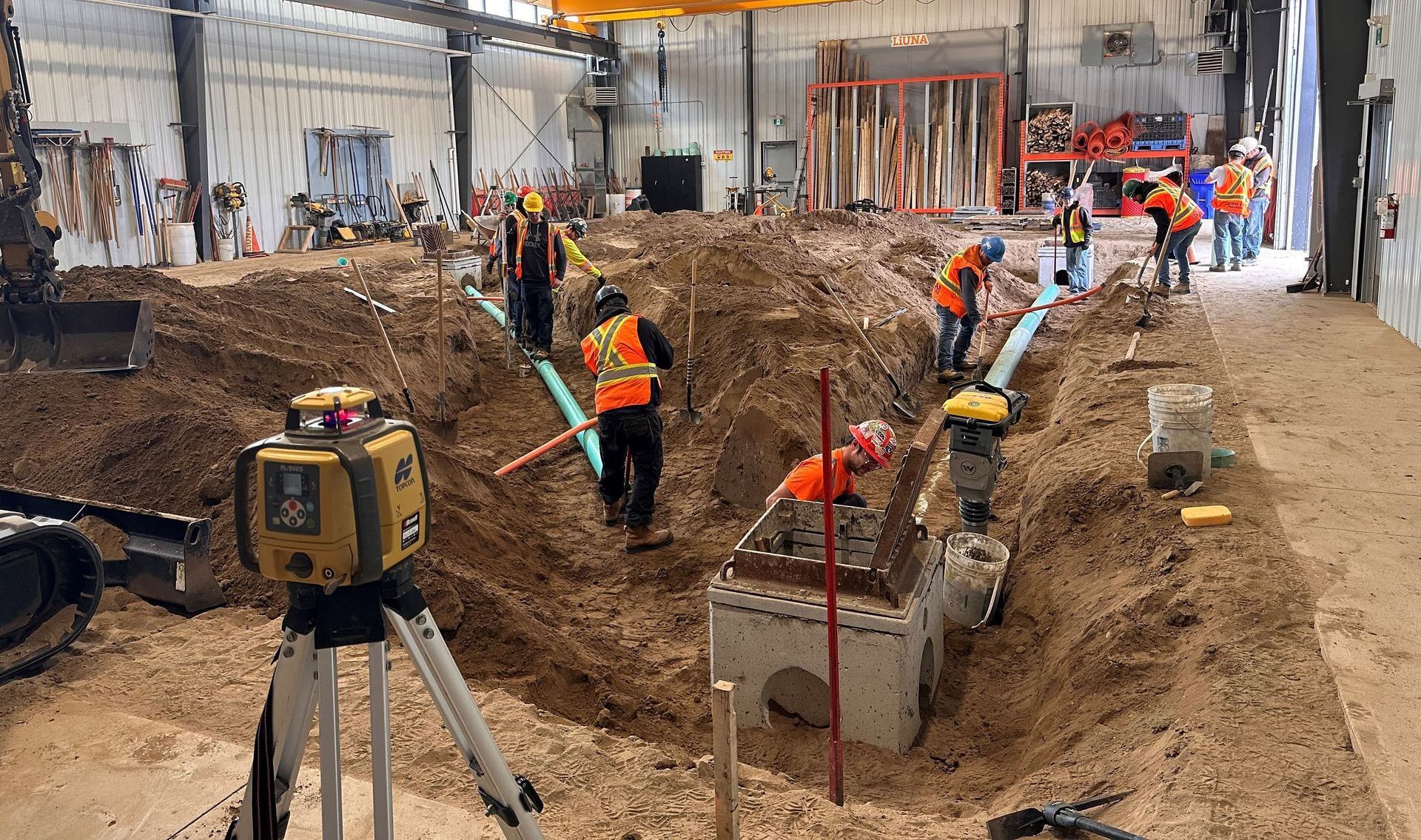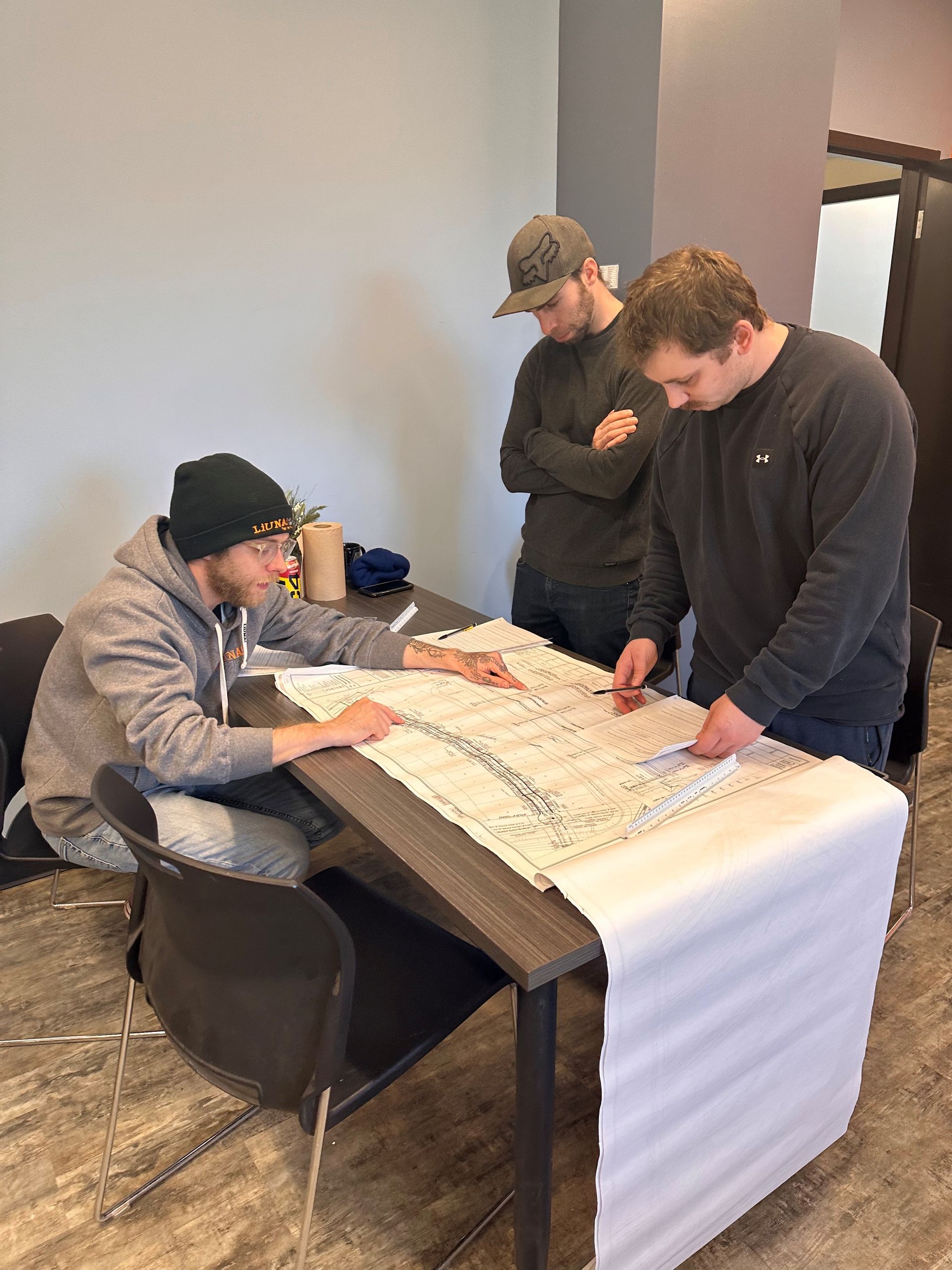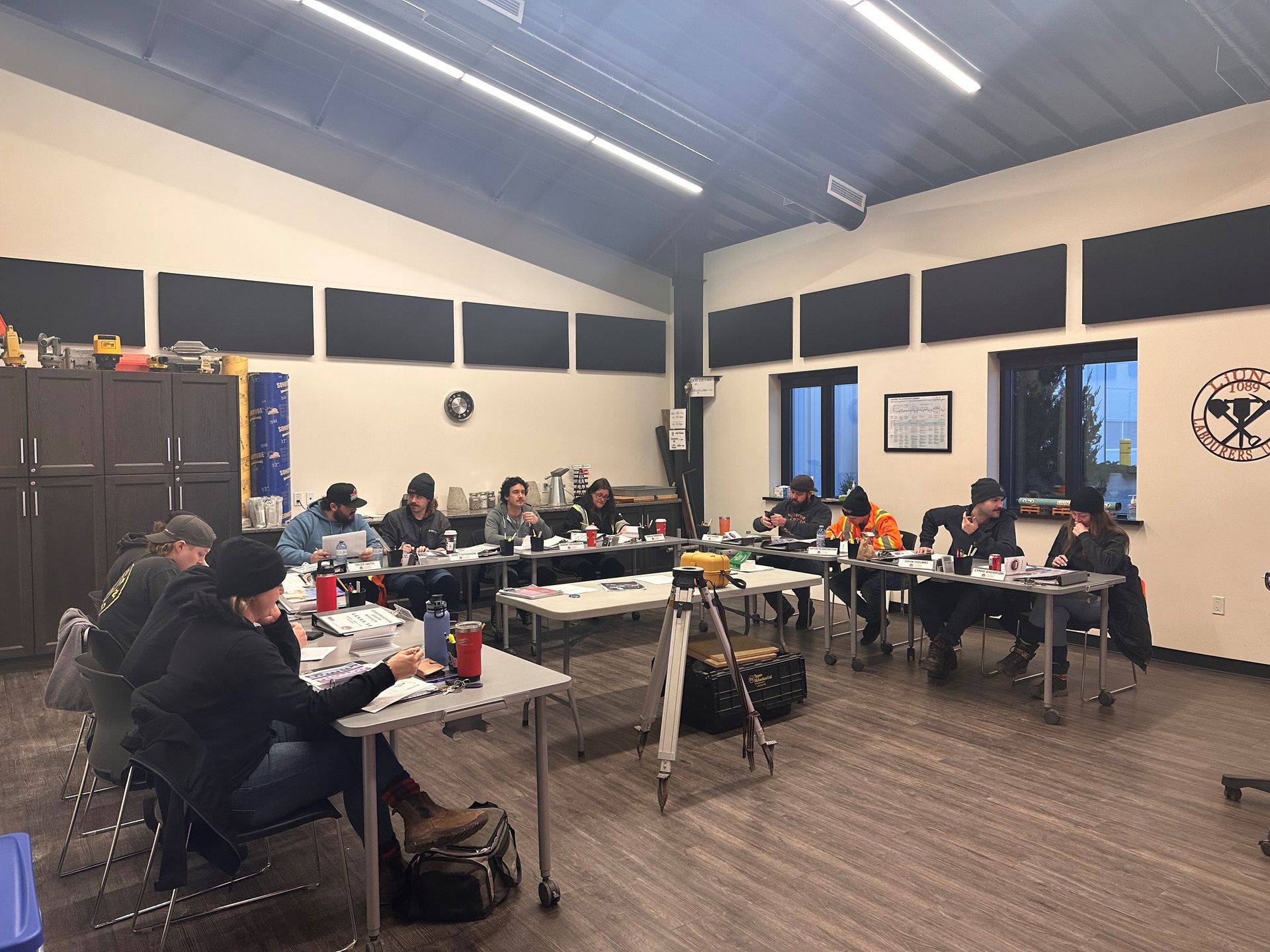HIGHLY QUALIFIED
SKILLS TRAINING
LiUNA Training and Education is an important part of the Laborers’ International Union of North America and one of the premier adult training organizations in the world. With over 70 affiliated training centers throughout Canada and the United States.
We provide employers with their most important resource: a highly trained, safe and effective workforce. Each year hundreds of thousands of workers are empowered to realize their dream of a lucrative and rewarding career in the construction industry.
COURSES OFFERED
Local 1089 Training Centre offers a wide variety of programs & courses in our new world class training facility. We strive to be recognized as a pinnacle training institution for LiUNA, the construction industry and our community.
The LiUNA Local 1089 Training Centre provides the most inclusive training programs to our dedicated apprentices and members by incorporating the new technologies and recognized methods of training delivery. We provide training that includes the use of new materials, tools and techniques that simulates present day job sites. Our model of adult education is a perfect balance of
- Theory
- Instructor Demonstration
- Hands-on training Practical Application.
-
ASBESTOS ABATEMENT WORKER TYPE 3 (MLTSD)
- 3 days
-
CONSTRUCTION CRAFT WORKER APPRENTICE (MLTSD)
Construction craft workers work mostly on construction sites; their tasks include site preparation and cleanup, setting up and removing access equipment, and working on concrete, masonry, steel, wood and pre-cast erecting projects. They handle materials and equipment and perform demolition, excavation and compaction activities. They may also perform site safety and security checks.
Construction craft workers work on a wide variety of structures such as residential, and industrial, commercial and institutional (ICI) sites, as well as hydroelectric dams, roadways, bridges, tunnels, mines and railways. In some jurisdictions, they may also work on utility, landscape and pipeline projects. Construction craft workers may work for private companies as well as municipal, provincial and federal governments.
With experience, construction craft workers who complete additional training may specialize in different areas of construction. This can include operating off-road vehicles, drilling, blasting, scaling, sandblasting, high-pressure washing, diving, tunnelling and performing emergency rescue. Another common responsibility is the management of pedestrian and vehicular traffic in situations involving potential hazards and public trust.
Construction craft workers work primarily outdoors, in all weather conditions. They are often required to work at heights, over water and in confined spaces and excavations. Their job settings may be in densely populated urban settings or at remote locations. They often work overtime during peak construction periods.
Key attributes for workers in this trade are mechanical aptitude, manual dexterity and an ability to do hard physical work. They must also be able to work both as team members, and sometimes, to interact directly with the public where considerations such as safety and legal liability are at issue. Organizational, leadership, problem solving and document interpretation skills are assets for anyone wanting to progress in this trade.
This analysis acknowledges similarities with many construction trades. With experience construction craft workers may have opportunities to advance.
-
CEMENT FINISHER APPRENTICE (MLTSD)
Concrete finishers place, finish, protect and repair concrete surfaces. They work on a variety of vertical and horizontal surfaces such as concrete floors, walls, sidewalks, stairs, driveways, curbs and gutters, and overlays. They work on many types of structures such as buildings, dams, bridges and tunnels. They also texture, chip, grind and cure finished concrete work and repair and restore damaged concrete. They apply architectural finishes to concrete surfaces such as exposed aggregate, acid-stained, patterned-stamped, broomed, smooth finishes and etched concrete surfaces. They install expansion and contraction joints and install fixtures such as anchor bolts, steel plates and other embedment’s. They also apply membranes and other waterproofing products to concrete. Concrete finishers must possess a sound knowledge of the properties of various types of concrete mixes and how proportions, additives and curing affect concrete strength and durability. Materials that concrete finishers work with include concrete, grouts, chemical-curing compounds, exotics, epoxies, polyurethanes and acrylics. Concrete finishers should have a basic knowledge of constructing formwork, preparing sub grades and installing reinforcement.
Much of concrete placing and finishing has become mechanized with power screeds, power trowels, mechanical vibrators and pumps. Hand troweling is still required for small jobs and to finish hard-to-reach spots in corners, edges, stairs and around obstacles such as pipes.
Concrete finishers work in the construction sector in both indoor and outdoor conditions. Outdoor work is weather-dependent and there may be less work available in the winter. Conversely, overtime is often required when the weather demands it.
Specialization in this trade is common. Concrete finishers specialize in working with specific materials such as coloured concrete, exposed aggregates and various epoxies, or specific techniques such as diamond-polishing concrete, power troweling, and finishing curbs and gutters.
Key attributes for people entering this trade are stamina, spatial perception and hand-eye coordination. Creative and artistic skills are also helpful in this trade. Some physical activities of this trade are heavy lifting, climbing, balancing, bending, kneeling, crouching, crawling and reaching.
Concrete finishers work with a variety of other tradespeople. Heavy equipment operators may prepare the sub-base for concrete, ironworkers may prepare and place the reinforcing material and carpenters may place the formwork. Concrete finishers inspect this work and ensure that it is suitable for receiving the concrete. They also interact with plumbers and electricians when pipes and conduits are embedded in the concrete.
With experience, concrete finishers may move into supervisory, management or instructing roles.
-
CHAINSAW SAFETY (IHSA CERTIFICATION
- 3.5 hours
-
TRENCHING SAFETY (IHSA CERTIFICATION)
- 3 hours
-
INDUSTRIAL EDUCATIONAL CO-OPERATIVE (IEC)
- WORKING AT HEIGHTS (IEC CERTIFIED) - 8 hours
- WORKING AT HEIGHTS REFRESHER (IEC CERTIFIED) - 4.5 hours
- CONFINED SPACE ENTRY & ATTENDANT AWARENESS (IEC CERTIFIED) - 3.5 hours
- SAFETY ATTENDANT AWARENESS (ME/SUPAIR/HW) (IEC CERTIFIED) - 1.5 hours
- FIT TEST (IEC CERTIFIED) - 1 hour
-
WORKERS HEALTH & SAFETY CENTRE (WHSC)
- CONSTRUCTION RIGGING & HOISTING – ESSENTIALS (WHSC CERTIFIED) - 2 days
- CONSTRUCTION RIGGING & HOISTING – FUNDAMENTALS (WHSC CERTIFIED) - 1 day
- PROPANE FOR CH-02 ROT (WHSC CERTIFIED)
- GLOBALLY HARMONIZED WHMIS (WHSC CERTIFIED) - 3 hours
- FORKLIFT TRAINING (WHSC CERTIFIED - 8 hours
- POWERED ELEVATED WORK PLATFORM OPERATOR (WHSC CERTIFIED) - 8 hours
- ROUGH TERRAIN FORKLIFT OPERATOR (WHSC CERTIFIED) - 8 hours
- SKIDSTEER OPERATOR - 8 hours
-
ST. JOHN AMBULANCE (on hold due to Covid-19)
- STANDARD FIRST AID/CPR-A/AED - 16 hours
-
SPECIALIZED
- RAILROAD MAINTENANCE TRAINING 2 weeks (CONTRACTOR REQUEST ONLY)
- CLOCKSPRING CERTIFICATION (CONTRACTOR REQUEST ONLY)
-
CURRENTLY IN DEVELOPMENT
- 3-DAY CUTTING AND TORCHING COURSE – DEMOLITION
- 8-WEEK PIPELAYING SKILLS TRAINING COURSE
-
ONLINE
- WHMIS
- PIPELINE CONSTRUCTION SAFETY TRAINING
- GROUND DISTURBANCE
-
RED SEAL DESIGNATION
The Construction Craft Worker is now recognized as a Red Seal Trade in Canada. It is the expectation of Local 1089 that all apprentices will successfully complete their Red Seal exam in a timely manner as part of their commitment to their trade.
What does this mean for those who enter into the apprenticeship program?
The Red Seal program represents industry's recognition of an interprovincial standard of excellence for the skilled trades. Through the program, apprentices who have completed their training and become certified journeypersons are able to obtain a Red Seal endorsement on their provincial or territorial Certificates of Qualification and Apprenticeship by successfully completing an interprovincial Red Seal examination. Local 1089 Training Centre will help all apprentices prepare for the exam by administering a test prep week, prior to writing the Red Seal exam.
For 50 years, Canada's provinces and territories have worked together to build the Red Seal program, http://vimeo.com/11171616 a system of common standards for the skilled trades. A Red Seal certificate signals excellence to employers, instills pride in skilled workers, and promotes geographic labour mobility.
Construction Craft Worker - Exam Counselling Sheet
A Red Seal exam is based on the National Occupational Analysis (NOA) for the trade. The analysis describes the skills and knowledge required to perform the duties of the trade. Each NOA consists of blocks (main subject areas), each block is divided into tasks, and each task is divided into sub-tasks. Not all areas are tested on the Red Seal examination as the analysis identifies all tasks performed in the trade by apprentices, tradespersons and journeypersons.
To prepare for the Red Seal exam please use the NOA information below.
Percentage of questions for each block of the trade
Titles of blocks
Percentage (%) of questions on exam*
A - OCCUPATIONAL SKILLS 23
B - SITE WORK 19
C - SCAFFOLDING AND ACCESS EQUIPMENT 9
D - CONCRETE WORK 18
E - MASONRY WORK 10
F - UTILITIES AND PIPELINE 11
G – ROADWORK 10
Total 100
Visit Red Seal Site: www.red-seal.ca
Concrete Finisher - Examo Counselling Sheet
A Red Seal exam is based on the National Occupational Analysis (NOA) for the trade. The analysis describes the skills and knowledge required to perform the duties of the trade. Each NOA consists of blocks (main subject areas), each block is divided into tasks, and each task is divided into sub-tasks. Not all areas are tested on the Red Seal examination as the analysis identifies all tasks performed in the trade by apprentices, tradespersons and journeypersons. Not all areas are tested on the Red Seal examination as the analysis identifies all tasks performed in the trade by apprentices, tradespersons and journeypersons.
Percentage of questions on exam per blocs
Titles of blocks
Percentage (%) of questions on exam*
A - OCCUPATIONAL SKILLS 20
B - CONCRETE PLACEMENT 21
C - CONCRETE FINISHING 27
D - CONCRETE CURING AND PROTECTION 15
E - CONCRETE MODIFICATION, REPAIR AND GROUTING 17
Total 100
Visit Red Seal Site: www.red-seal.ca
-
Construction Craft Worker
Local 1089 Training Centre is a Training Delivery Agent (TDA) through The Ministry of Labour, Training & Skills Development (MLTSD) for the Cement Finishers trade and all apprentices from Local 1089 will complete their in-school training sessions here. The MLTSD is involved in registering and tracking the progress of apprentices, their schooling, and their hours of on-the-job training hours. Apprentices who are Employment Insurance (EI) eligible will continue to collect during their training sessions at Local 1089.
The in-school apprenticeship program is the same one used at all other approved TDAs across Ontario and is approved by the MLTSD.
Construction craft workers work mostly on construction sites; their tasks include site preparation and cleanup, setting up and removing access equipment, and working on concrete, masonry, steel, wood and pre-cast erecting projects. They handle materials and equipment and perform demolition, excavation and compaction activities. They may also perform site safety and security checks.
Construction craft workers work on a wide variety of structures such as residential, and industrial, commercial and institutional (ICI) sites, as well as hydroelectric dams, roadways, bridges, tunnels, mines and railways. In some jurisdictions, they may also work on utility, landscape and pipeline projects. Construction craft workers may work for private companies as well as municipal, provincial and federal governments.
With experience, construction craft workers who complete additional training may specialize in different areas of construction. This can include operating off-road vehicles, drilling, blasting, scaling, sandblasting, high-pressure washing, diving, tunnelling and performing emergency rescue. Another common responsibility is the management of pedestrian and vehicular traffic in situations involving potential hazards and public trust.
Construction craft workers work primarily outdoors, in all weather conditions. They are often required to work at heights, over water and in confined spaces and excavations. Their job settings may be in densely populated urban settings or at remote locations. They often work overtime during peak construction periods.
Key attributes for workers in this trade are mechanical aptitude, manual dexterity and an ability to do hard physical work. They must also be able to work both as team members, and sometimes, to interact directly with the public where considerations such as safety and legal liability are at issue. Organizational, leadership, problem solving and document interpretation skills are assets for anyone wanting to progress in this trade.
This analysis acknowledges similarities with many construction trades. With experience construction craft workers may have opportunities to advance.
Courses taught in the sixteen week program include:
History and Scope of the Cement (Concrete) Finisher Trades
Communications and Presentation
Trade Calculations and Quantities
Blueprints, Specifications and Layout
Construction Safety
Hand Tools
Power Tools and Equipment
Concrete Technology
Site Preparation
Place and Level Concrete
Finish Concrete
Concrete Curing and Protection
Cut Concrete
Repair and Resurface
Specialty Concrete
Architectural Finisher
Introduction to Epoxy Systems
CF in-school sessions are scheduled by the MLTSD.
CF apprentices are awarded the Certificate of Apprenticeship by the MLTSD when they have achieved the following:
Successful completion of the two eight week in-school sessions;
Successful completion of on-the-job training;
MLTSD log book filled out;
Local 1089 Business Manager signs off, confirming apprentice has met all requirements;
Successful completion of the Provincial Examination (70% pass); and Notification by the apprentice to the MLTSD that all requirements have been met, with documentation to prove this.



